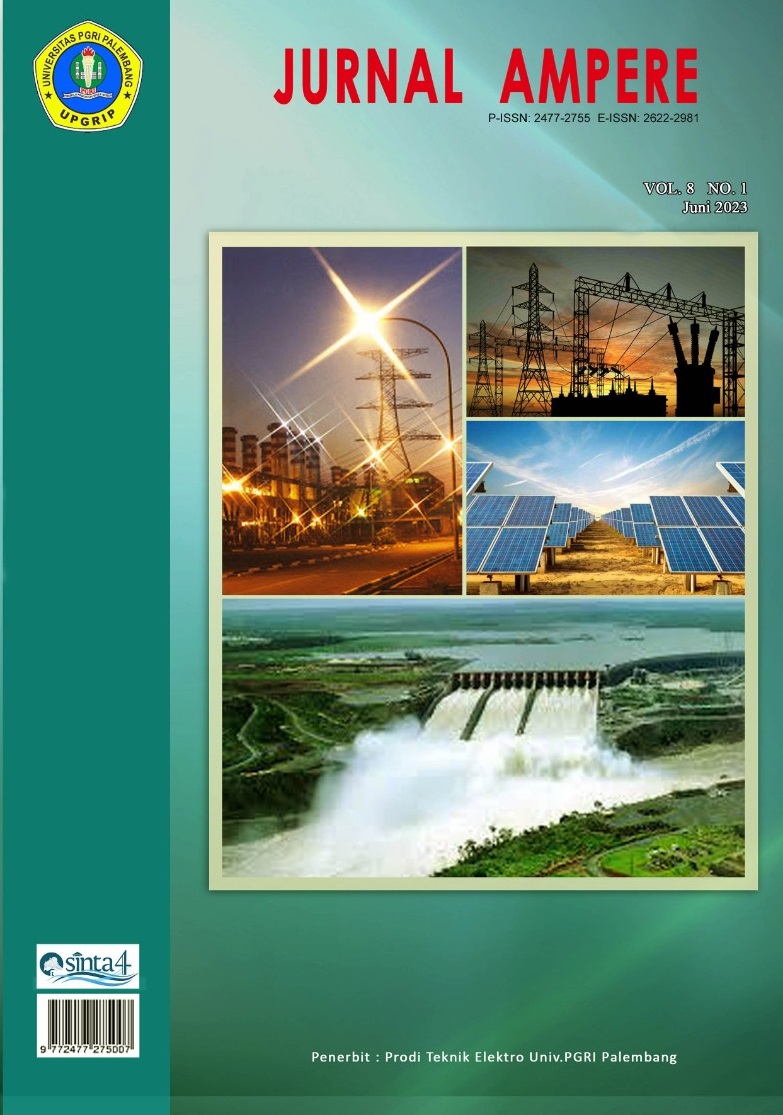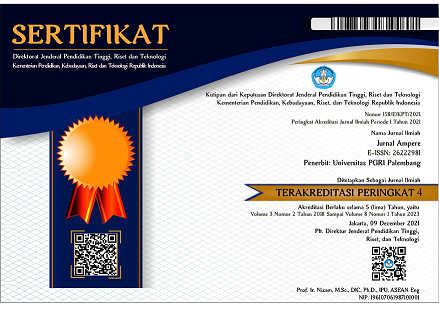Pengendali Kecepatan Motor DC Terhadap Perubahan Suhu Menggunakan PLC dan Human Machine Interface
DOI:
https://doi.org/10.31851/ampere.v8i1.12345Keywords:
Programmable logic controller, Termokopel, Motor DC, Human Machine InterfaceAbstract
Controlling the speed of a DC motor in proportion to changes in temperature of a K-type thermocouple uses a Programmable Logic Controller and the Human Machine Interface to enable monitoring of the temperature and speed of the Direct Current motor from changes in the thermocouple sensor as input in the form of temperature data reduced to analog. to digital converter in the form of digital data and controls the speed of the DC motor by adjusting the Pulse Width Modulation. DC motor speed control for temperature changes from a thermocouple sensor with a control system using a Programmable Logic Controller and displayed on the Human Machine Interface. In this test, only heating the sensor at a temperature of 30 oC to 100 oC and the speed of the DC motor where the temperature is greater, the PWM value makes the DC motor rotate faster. In controlling DC motors with PWM using a frequency of 10 Hz to get a PWM value of 0% - <54% the motor will rotate at low speed. PWM 54% - <84%, the motor will rotate at medium speed. PWM 84% - >90%, the motor will rotate at high speed
References
H. Wicaksono, SCADA Software Dengan Woderware InTouch”. Yogyakarta: Graha Ilmu.
T. Schneider, “Training handout Politeknik Negerii Sriwijaya PLC dan HMI.” pp. 4–6,.
M. I. Ramadhani, “Sistem Pengendali Motor DC Dengan Pulse Width Modulation berdasarkan Perubahan Suhu Thermocouple Berbasis PLC“,” Politek. Negeri Sriwijaya. Indones..
F. D. dkk, “Prorammable Logic Controller Pengatur Kecepatan Motor AC Terhadap Perubahan suhu Termokopel,” Pros. Sent., pp. 240–247,.
N. Harmein, “Prorammable Logic Controller”.” Erlangga, Jakarta.
N. N. dkk, “Analisa Motor DC (Direct Current)“,” J. Mikrotiga, vol. l, no. 2, pp. 28–34,.
A. Sugeng, Monitoring Suhu Menggunakan SCADA”. Politeknik Negeri Sriwijaya. Indonesia.
A. K. J. dkk, “Rancangan observer untuk Motor DC pada PLC,” in J.Teknik ITS Vol.9 No.2,
T. Schneider, “Twido Suite V2.3 Programming Guide, pp.163.”
F. B. L. dkk, “Implementasi Pulse Width Pada Penyaluran Limbah Cair Pupuk Kelapa Sawit Berbasis Arduino,” J.Electrical Technol., vol. l, no. 2, pp. 39–46,.
Downloads
Published
How to Cite
Issue
Section
License
Copyright (c) 2023 Masayu Anisah, Amperawan Amperawan, Sabilal Rasyad , Herman Yani , Anton Firmansyah

This work is licensed under a Creative Commons Attribution-ShareAlike 4.0 International License.

Jurnal Ampere is licensed under a Creative Commons Attribution-ShareAlike 4.0 International License.
Authors who publish with this journal agree to the following terms:
- Authors retain copyright and grant the journal right of first publication with the work simultaneously licensed under a Creative Commons Attribution License that allows others to share the work with an acknowledgement of the work's authorship and initial publication in this journal.
- Authors are able to enter into separate, additional contractual arrangements for the non-exclusive distribution of the journal's published version of the work (e.g., post it to an institutional repository or publish it in a book), with an acknowledgement of its initial publication in this journal.
- Authors are permitted and encouraged to post their work online (e.g., in institutional repositories or on their website) prior to and during the submission process, as it can lead to productive exchanges, as well as earlier and greater citation of published work.






